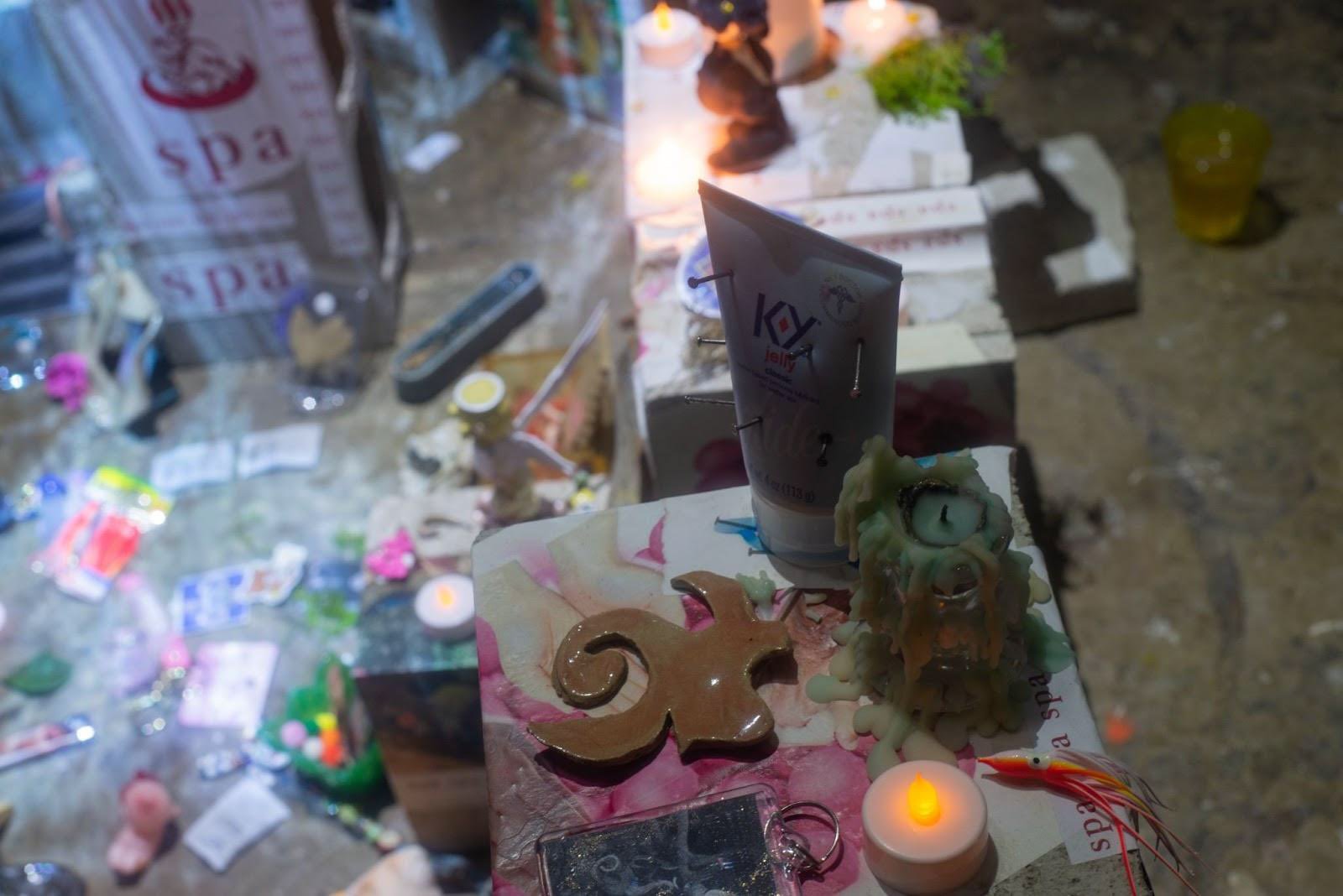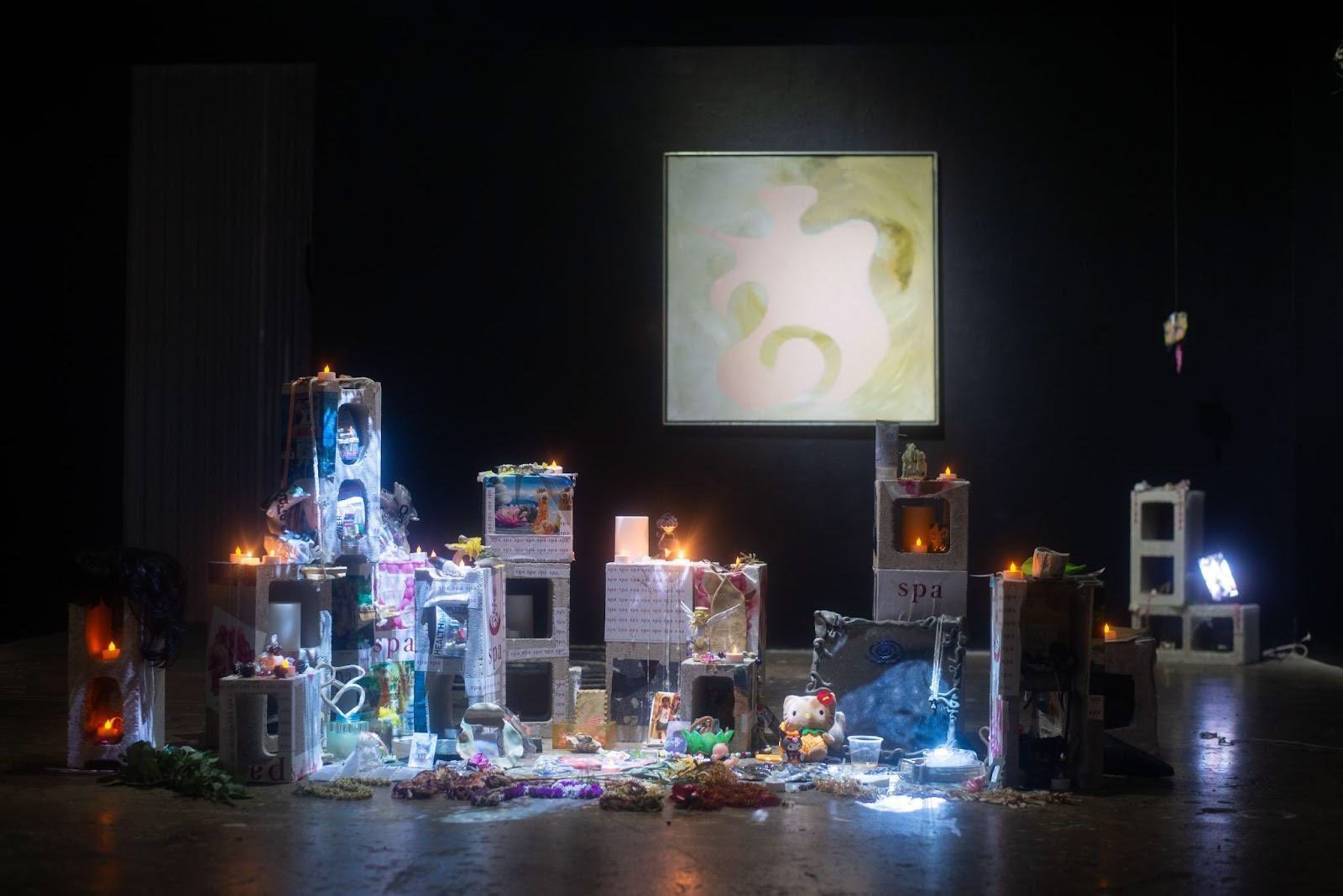SPA: healing object
Welcome to SPA: healing object.
This is an oracle exercise transcribed by jasbunnie featuring Jasmine Reiko and Pecorino for the purpose of activating SPA: healing object’s connection with the divine through the medium of digital translation and free association. Through revelations in memory and relationships comes being out of body, an elevated no-place, which invites the idea of being everywhere in-thought with a grounded now. At the site of SPA: healing object comes moments which cast each square unit, breath, and bow with a sense of belonging that manifests with most acts of worship. This conversation comes from the making and installing of the shrine, the activation of its altar, and the after-care of dismantling offerings and fixtures from its four-week exhibition at Aupuni Space located in Kaka’ako, Honolulu, Hawai’i.
SPA: healing object considers the energy of accumulation/collecting for no reason, of taking/investing for no reason regardless of holy or mundane interaction. Maintaining reverence both private and public, extending and sustaining the concept of shrines past their physical site into an atmosphere that is all accessible yet chaotic in its freedom and lavish insistence in the now. Performing restorative strategies of trade, reception, and worship as a practice of losing-self, SPA exhibits a collection of healing objects washing its users with supernatural relaxation.
Pecorino (b. 1998) is a 62 year old spa technician from Dumaguete City, Philippines. Plagued by compulsive skin picking, they seek regeneration in pockets of time, deep within each pore, a crater for solitude and enlightenment. Pecorino has over 200 skin cells to date. They have been featured in Tropic Zine Issues 1–3, and Hawai‘i Triennial 2022.
Jasmine Reiko (b. 1997) is a tender hyperstition. Their prayers land with roots, philosophy edible. Stories lined with fur, they smell like a wet dog. Handmade with pure images, Reiko is a self-erasure as self-betterment ritual. Reiko stands between enclosed sacred interiors and boundless horizon. Their work has been featured in Snuff Magazine and Hawai‘i Triennial 2022.
rest, repent, relax, redeem
Jasbunnie: What kind of landscape do you think about when you enter the gallery space because you weren’t there when the install ended so I am sure it turned into something totally other than what you last saw. Were there any feelings or first emotions you’ve had that you may not have experienced throughout the making of the show?
Pecorino: Through the making of the show, my sensations were fleeting, surface-level. Unsolidified, just variations of feeling within carbonation. (pop. pop. pop.). When it was completed it felt like… when you boil meat and you skim the fat off. It felt like skimming the fat off and putting it in a separate bowl.
J: And that was the show?
P: Yeah. The fat that rises up to the top and solidifies when cool..
J: What is your favorite thing happening at SPA: healing object?
P: I wasn’t there for it, but the footage of everyone bowing towards the center of the room on opening night. Everything became centralized from that shrine. The show opening, also called the reception, when the shrine was received - it was ceremonious.
J: As a spectator of your show from Portugal, how did you feel to know that these people that you did and didn’t know were bowing and sitting with an altar that you have created?
P: I feel half disconnected from it. Since I couldn’t witness the strangers’ reception, I only imagined our friends. Our preset audience.
P: At churches, they have actual service, sessions of gathering and teaching, but you can go at any point in time to pray. You can light incense, a candle - you leave an offering. It isn’t mediated or officiated, but it’s real. It’s sacred and important. When people interacted with our shrines, it felt like a ghost in a room to me. I could see their offerings, their contributions, but I couldn’t understand where or who they came from. It was interesting to see that connection by seeing what they chose to leave. There was this empty vape cartridge - I like the idea of trash items as an offering. At a church altar, you see countless candles, some whose light already has gone out. You witness their devotion, and superficially, you understand it, but you don’t really know what they prayed for.
J: Used items. Someone left a note on a napkin that they used. Even the empty vape cart is someone’s used vape cart.
P: Imbued with action, history, actual DNA remnants. As valueless as they seem, it’s a much greater insight to their moment of prayer than a candle.
J: I feel the shrine itself also encapsulates our action and history throughout a few months of having the studio upstairs and fucking around, seeing what we saw felt fit. Moving around and through what we understood as SPA. A lot of the final items were actually collected throughout the last couple months we were there. We have accumulated so much, we have all these other pieces, it’s a show about accumulation, too.
P: Accumulation. One of our goals in the beginning: putting use to things that we have collected. Especially when you collect something that is nonsensical, getting to display it does not make sense. Like the lint I collect, I just have it in Ziploc bags in your drawer. I’m thinking of how people do “What’s In My Bag?” videos. People want to know what your daily items are, what’s so important to you that you bring it with you everywhere - but part of that reality is things like crumbled-up receipts, trash. People display their favorite things in a particular way, it becomes a shrine of its own, like your shelf full of trinkets at home. But I want to know what’s in your bag really, what has accumulated unintentionally? What didn’t you throw away yet and why.I really like that idea.
J: And that is something that we did. All the things that we have in our studio that is this hidden space upstairs that nobody can really see except those who have been a part of the show in some way will see how absurd it was. It was a whirlwind of things going on in different corners. We had paper mache all over the ground and you nailing together two wooden panels into each other, burning fleshlights into the wood, nails everywhere on the walls because I figured out how to use a hammer apparently… I like the idea of accumulating for no reason as this thoughtless process where objects usually have this assigned material importance that I did not really want to see during this show. We have oysters for crucifixes. Ceramic pamphlets. I think there are some moments where you can be at an altar, whether that altar is your own traveling mentality, and you can think intrusive thoughts, not solely prayer, and be very far away from your rational self and just be uninhibited. Like, fucking around for no reason. A lot of people were drawn to your poem about your hello kitty shrine. That energy is present especially in our anchor, the altar, amongst the floating ephemera that circle and spiral out from that median.
P: I feel the unintentional accumulation that most of the works encompass has a narrative strung through them. Like sticking a beading needle in a jar of mixed beads, scooping those beads from a jar, they aren’t selected one by one. They are thrust onto the string by fate. What is the subconscious narrative that threads itself through the physical?
J: I like how accidental these shrines were.
P: They kind of grew on their own.
J: Like Stonehedge.
P: Literally like Stonehedge. If you put these objects in the room, what would happen? I feel like the objects moved on their own and exchanged energies with each other: the packets of gas station pills. A fake finger. Fake hands. Byproducts of making stuff in the space. A lot of wrappers. A lot of wooden spoons from an ice cream that said Sophisticated or Classy which are things you wouldn’t think of when you think of wooden spoons. There were a bunch of sugar packets that we collected because of the font. Things we had no use for but didn’t dare to discard.
J: Most of these were our offerings to the shrine even unintentionally of our time spent.
P: This is proof.
J: This is evidence of our time here.
P: The objects, they are our witnesses. Just as we witness them.
P: If you were looking for divination, would you feel more trusting having your source, your answers provided by something temporal or something cemented in place? A vagrant versus a pillar of the community. I feel there is something about travelers, someone who is fleeting that feels more safe and secretive. the data that you give them or that they give you has one opportunity for witness. A stagnant body can leak.
J: The idea of entering into SPA: healing object is that you are traveling into this new place. It looks like a temple, it acts like a temple, it sounds like a lot of temples, there are things that are placed there that make it feel like a temple, but I invited the idea of coming with any thought and being thoughtless and traveling in and out. The space is secondary. It is the residue of our time spent there that involves people moving around us. I think sitting down and having a moment with the shrine can be emotional, thoughtless, or even worthless, but these things will pass through and I will not tell you how to feel about it or what to think, what to feel is worthy.
photos by JASON CHU, edited by PECORINO 2022
thanks to AUPUNI SPACE
words JASMINE REIKO
What to read next

























